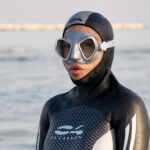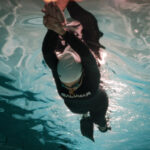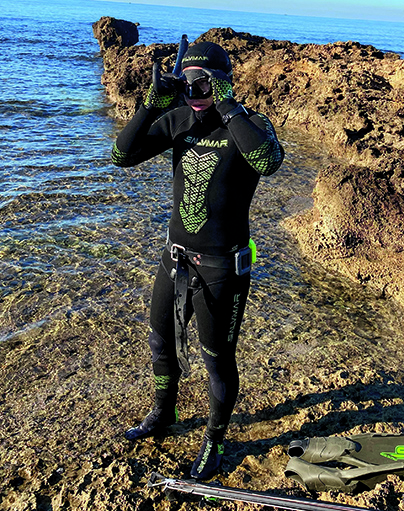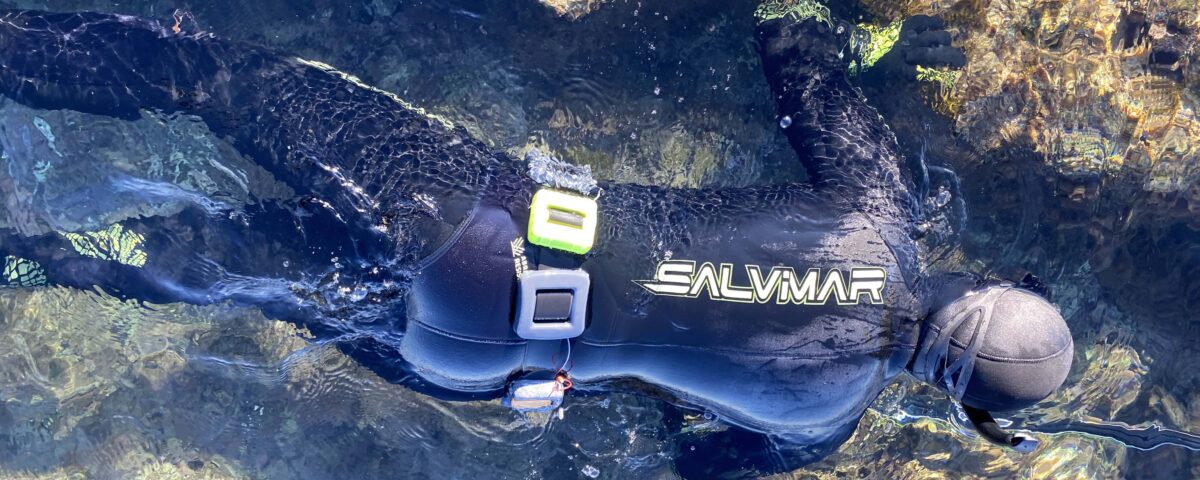Salvimar: Spearfishing 101

C4: Sideral wetsuit for women
27 February 2025
Salvimar: Apnea Rise Lady
4 March 2025We tested the 7mm version of this wetsuit made from Yamamoto 39 open-cell neoprene combined with a Lycra Spandex lining, a combination that makes it truly unique in terms of softness, thermal efficiency, and fit. This is a brand new product that the company plans to launch this month, February
Cristian Righetti
As soon as I opened the package, the wetsuit was inside a plastic bag for protection, wrapped in thin tissue paper. I opened it and began examining the details.
The Ligurian company chose to use the famous Japanese Yamamoto neoprene, opting for a 39 blend, which guarantees great thermal efficiency, ultra-light weight, and softness. This means great freedom of movement and almost eliminates the "cage effect," which is a discomfort that occurs, especially with thicker wetsuits like the 7mm we tested. It’s that feeling of tightness or compression around the chest that prevents proper ventilation and relaxation.
As mentioned, the neoprene is paired with an ultra-elastic Spandex outer lining. The choice of ultra-elastic Lycra ensures the properties of Yamamoto 39 are not compromised.
The wetsuit features an anatomical cut, with a design named 101 (which is reflected in the product name). This cut, used with super-elastic and soft materials, reduces the average cutting dimensions of the foam sheets compared to working with other types of neoprene, resulting in a suit that fits the diver’s body more closely.
The color scheme is total black with olive green lettering. Both forearms and the right leg have large military-green-scaled rings, more decorative than functional. This texture is also present on the large chest support, giving the suit a very attractive look.
Looking at the details, the Salvimar logo appears on the front of the hood, chest, both forearms, and down the left side of the back. On the pants, it is printed on the left thigh. The “Spearfishing 101” label is positioned at the bottom, on the side of the generous chest support.
One of the first things I like to check in wetsuits are the seams, as they indicate the craftsmanship of the product. Here we have internal/external double stitching with the GBS system, which consists of an internal double-needle stitch that does not pass through and has a central two-component adhesive, ensuring waterproofness and offering greater durability and strength.
An interesting detail is that the glue used is water-based, supplied by Yamamoto, and therefore solvent-free—this is quite an eco-friendly approach.
On the wrists, ankles, waist, and face, the Rss (Real Seal System) technology is used to ensure waterproofing and eliminate water infiltration. For the beaver tail, Salvimar has chosen a double quick-release button system: practical, secure, and easy to use.
For areas requiring extra protection, like the seat and knees, the company has implemented the Abrasion Resistant CM501 system. These reinforcements, made from anti-abrasion materials designed in-house, minimize damage from contact and accidental cuts in areas most exposed to wear. The chest support is large and covers the area from above the chest to just above the belly button. Heat-pressed scales are placed above it to mimic fish scales and prevent the speargun from slipping while loading.
The Spearfishing 101 is produced in three thicknesses: 3.5, 5, and 7mm, and in sizes ranging from S to XXXL.
In the water
It’s December, the day is gloomy, and the sea is calm. I put the wetsuit on in the shower, given the outside temperature of 14°C, using the usual soapy water solution. The pants go on in a few seconds. Once the jacket is on, I adjust the arm seams to align with my upper limbs, all without any issues and with maximum comfort. Within minutes, I’m ready! I’m wearing a size 3 (equivalent to a M), and I must say the cut fits perfectly to my body. To complete the outfit, I wear Tactile 3mm gloves and socks.
I reach the dive spot after a short drive. Even during the ride, I feel no discomfort and enjoy the seaside view until I reach the parking lot. Even before entering the water, while putting on my fins on a rock, I can immediately test the reinforcements on the gluteal area, which cushion the roughness of the limestone rock.
Finally in the water, I felt a bit of water infiltration around the ankles (due to the lined socks) and around the stomach area; for the latter, it would have been perfect if the waistband were smooth rather than lined, so the open-cell Yamamoto material in the jacket would seal perfectly with the pants. However, in winter, this can be solved with a pair of Bermuda shorts, which seals everything.
Loading the speargun is natural thanks to the generous reinforcement and the grip offered by the heat-pressed scales, preventing any slipping.
Breathing is fluid and natural, not obstructed by the neoprene, even with the 7mm thickness. I prepare for a dive and descend. I’m waiting in just 2 meters of water for about two hours, the temperature is around 15°C, and so far, I’m staying warm. Personally, I’ve never fished with 7mm pants, and I was initially a bit doubtful, especially regarding the actions and movements, but I didn’t notice any difference, except for the positive thermal comfort that I wasn’t used to.
I fished mainly by ambush and had planned for a base weight of 10–11 kg, adjusting with rocks gathered from the bottom and placed between the belt and back support.
The wind from the land is not favorable for fish, and I’m about to give up when, on the umpteenth ambush, I spot an immobile barracuda, perhaps digesting; the fish’s head is facing outward, and I approach from behind: aim, shoot, and spear it.
The three hours are nearly up, and I haven’t felt any cold; I could continue, but I decide to finish the session. I’m surprised by the suit’s performance. Despite the 15°C water, I felt great, with no sign of cold and, most importantly, I didn’t feel any discomfort or restriction in movement, which often happens with such thick suits.
After several outings (a couple in January as well), I can confidently say this wetsuit offers comfort and thermal power that only a neoprene like Yamamoto can deliver, combining it with top-notch durability.
All in all, an amazing wetsuit for winter shore dives, even for those who don’t pay particular attention to potential bumps or abrasions during fishing, which are always possible when stalking fish in rough seas. Salvimar has hit the mark once again!
Ratings!
Fit: the Spearfishing 101 fits perfectly, thanks to its patented anatomical 101 cut. There are six available sizes (S-XXXL). The beaver tail with double buttons makes dressing easy and ensures a secure closure. 9
Finishing: nothing to complain about, as is customary with Salvimar products. One point off for the lack of a high waistband on the pants. 8
Durability: the Spandex outer lining provides good protection. The chest area has a padded neoprene cushion, and the seat and knee areas feature the efficient Abrasion Resistant CM501 anti-abrasion system. 8
Comfort
Excellent. Nothing more to add. 9
Price/Quality Ratio: in specialty stores, the jacket is priced at around €270, and the pants at €190. It’s not cheap, but quality comes at a cost. 8
Technical Specifications
Material: Yamamoto 39 open-cell neoprene and super-elastic outer lining
Seams: Double internal non-passing stitches with GBS system and central two-component adhesive
Chest reinforcement: Yes
Protections: Anti-abrasion material on knees and seat
Finishing: Rss technology on wrists, ankles, face, and waist
Beaver tail: With double quick-release button system



